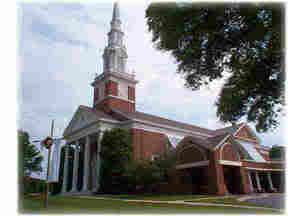victim divine
A few years ago the United Methodist Church published a supplement to the Hymnal entitled The Faith We Sing. It includes praise choruses (“How Majestic Is Your Name”), gospel songs (“The Lily of the Valley”), and more recent contributions that have been used widely in various communities within the larger church (“I Was There To Hear Your Borning Cry”, “Sing Alleluia To The Lord”).
Included in this volume is a Charles Wesley text entitled “Victim Divine”. This Eucharistic hymn is based on Hebrews 10. 12-22, and upon first listening it is unusual by out current standards: there is no repetition of text; there is within the hymn a complexity of design in the text’s movement from beginning to end, a complexity that requires attention of the mind; and the hymn is multi-sensory (an attribute often given to contemporary or alternative worship). “Victim Divine” is also deeply scriptural, almost a commentary on the Hebrews text, and it is profoundly doctrinal, in that it wrestles with beliefs about God and Jesus Christ, the meaning of salvation and authentic worship.
The first stanza is an affirmation of the grace of God in the sacrificial offering of Jesus Christ upon the altar. The sacrifice is “once offered up, a spotless Lamb”. Here there is an echo of Hebrews 10. 11-12, which describes the complete and sufficient offering of Christ, in contrast to that of the priests which are offered “again and again”, and Exodus 12. 5, which contains the instructions for the Festival of the Passover (“Your Lamb shall be without blemish”). Christ is the atonement for our sin and the Passover lamb that secures our salvation.
The second stanza places Christ in the “holiest place”, the holy of holies, where the offering for sin and guilt is made. There he intercedes for us; the letter to the Hebrews holds together the perfection of Christ’s sacrificial priesthood (7. 26-27) and the humanity of his offering (4. 14-15). In the holiest place, before God, Jesus prays for us, and the blood of sprinkling, symbolic of mercy and forgiveness, extending back to the Passover and forward to the New Covenant “spreads salvation all around”. Salvation is offered to all. Atonement is unlimited.
The third stanza connects the offering of Christ with the events surrounding the crucifixion. “The smoke of the atonement here darkened the sun and rent the veil”. The darkness (Matthew 27; Luke 24) recalls the ninth plague (Exodus 10) and the prophetic vision of Amos:
Why do you want the day of the Lord? It is darkness, and not light. (5. 18)
On that day, says the Lord God, I will make the sun go down at noon,
and darken the earth at broad daylight. (8. 9)
When Jesus cries with a loud voice and gives up his spirit (breathes his last breath, the offering is complete (Matthew 27. 50). It is finished (John 19. 30). At this moment, Matthew writes, “the curtain of the temple is torn in two, from top to bottom”(Mark 15. 38; Matthew 27. 51). Donald Juel likens the tearing of the temple in the death of Jesus to the opening of the heavens in Jesus’ baptism (Matthew 3; Luke 3). There is an openness to the Holy in the revelation [uncovering] of God who looks down upon prodigal children as royalty.
This fourth stanza is marked by a multi-sensory character:
He still respects thy sacrifice/its savor sweet doth always please
The offering smokes through earth and skies,
Diffusing life, and joy, and peace
To these thy lower courts it comes/and fills them with divine perfumes.
The burning of incense by the high priest was for the purpose of pleasing God. The sacrificial death of Christ (Ephesians 5. 2) has cosmic dimensions, descending even to us. “Victim Divine” concludes with a remarkable statement about the meaning of salvation:
We need not go up to heaven/to bring the long sought Savior down;
Thou are to all already given, thou dost e’en now thy banquet crown:
To every faithful soul appear/and show thy real presence here!
Salvation is not our achievement or ascent to God. Salvation is God’s gift to us, in the incarnation, in the One who empties himself and takes the form of a servant and becomes obedient unto death, even death on a cross (Philippians 2). God comes down to us, in the incarnate (human ) Jesus, and in the material elements of Holy Communion. The real presence of Christ at the table, the body and the blood of the Lamb who takes away the sin of the world, has already been given to us. The sacrifice is complete, sufficient and effective . Therefore we enter the sanctuary with “a true heart in full assurance of faith” (Hebrews 10. 22).
Communion texts, whether they be anthems or hymns, convey a variety of messages, among them mystery , invitation , unity (“One Bread, One Body”), and spiritual hunger (“You Satisfy The Hungry Heart”). “Victim Divine” recaptures the sacrificial meaning of Holy Communion, which lies at the heart of all other meanings, and places the experience of receiving with bread and the cup within both Old and New Testament traditions. Its depth is both challenge and gift, and yet it offers the potential for a human response to God that involves the whole self in all of the senses: singing the hymn, touching and eating the bread, smelling the incense, in the midst of darkness, a light which can no longer be covered. We do not need to go up to heaven to have a spiritual experience. In Christ, God has made that available to us here, now.
Included in this volume is a Charles Wesley text entitled “Victim Divine”. This Eucharistic hymn is based on Hebrews 10. 12-22, and upon first listening it is unusual by out current standards: there is no repetition of text; there is within the hymn a complexity of design in the text’s movement from beginning to end, a complexity that requires attention of the mind; and the hymn is multi-sensory (an attribute often given to contemporary or alternative worship). “Victim Divine” is also deeply scriptural, almost a commentary on the Hebrews text, and it is profoundly doctrinal, in that it wrestles with beliefs about God and Jesus Christ, the meaning of salvation and authentic worship.
The first stanza is an affirmation of the grace of God in the sacrificial offering of Jesus Christ upon the altar. The sacrifice is “once offered up, a spotless Lamb”. Here there is an echo of Hebrews 10. 11-12, which describes the complete and sufficient offering of Christ, in contrast to that of the priests which are offered “again and again”, and Exodus 12. 5, which contains the instructions for the Festival of the Passover (“Your Lamb shall be without blemish”). Christ is the atonement for our sin and the Passover lamb that secures our salvation.
The second stanza places Christ in the “holiest place”, the holy of holies, where the offering for sin and guilt is made. There he intercedes for us; the letter to the Hebrews holds together the perfection of Christ’s sacrificial priesthood (7. 26-27) and the humanity of his offering (4. 14-15). In the holiest place, before God, Jesus prays for us, and the blood of sprinkling, symbolic of mercy and forgiveness, extending back to the Passover and forward to the New Covenant “spreads salvation all around”. Salvation is offered to all. Atonement is unlimited.
The third stanza connects the offering of Christ with the events surrounding the crucifixion. “The smoke of the atonement here darkened the sun and rent the veil”. The darkness (Matthew 27; Luke 24) recalls the ninth plague (Exodus 10) and the prophetic vision of Amos:
Why do you want the day of the Lord? It is darkness, and not light. (5. 18)
On that day, says the Lord God, I will make the sun go down at noon,
and darken the earth at broad daylight. (8. 9)
When Jesus cries with a loud voice and gives up his spirit (breathes his last breath, the offering is complete (Matthew 27. 50). It is finished (John 19. 30). At this moment, Matthew writes, “the curtain of the temple is torn in two, from top to bottom”(Mark 15. 38; Matthew 27. 51). Donald Juel likens the tearing of the temple in the death of Jesus to the opening of the heavens in Jesus’ baptism (Matthew 3; Luke 3). There is an openness to the Holy in the revelation [uncovering] of God who looks down upon prodigal children as royalty.
This fourth stanza is marked by a multi-sensory character:
He still respects thy sacrifice/its savor sweet doth always please
The offering smokes through earth and skies,
Diffusing life, and joy, and peace
To these thy lower courts it comes/and fills them with divine perfumes.
The burning of incense by the high priest was for the purpose of pleasing God. The sacrificial death of Christ (Ephesians 5. 2) has cosmic dimensions, descending even to us. “Victim Divine” concludes with a remarkable statement about the meaning of salvation:
We need not go up to heaven/to bring the long sought Savior down;
Thou are to all already given, thou dost e’en now thy banquet crown:
To every faithful soul appear/and show thy real presence here!
Salvation is not our achievement or ascent to God. Salvation is God’s gift to us, in the incarnation, in the One who empties himself and takes the form of a servant and becomes obedient unto death, even death on a cross (Philippians 2). God comes down to us, in the incarnate (human ) Jesus, and in the material elements of Holy Communion. The real presence of Christ at the table, the body and the blood of the Lamb who takes away the sin of the world, has already been given to us. The sacrifice is complete, sufficient and effective . Therefore we enter the sanctuary with “a true heart in full assurance of faith” (Hebrews 10. 22).
Communion texts, whether they be anthems or hymns, convey a variety of messages, among them mystery , invitation , unity (“One Bread, One Body”), and spiritual hunger (“You Satisfy The Hungry Heart”). “Victim Divine” recaptures the sacrificial meaning of Holy Communion, which lies at the heart of all other meanings, and places the experience of receiving with bread and the cup within both Old and New Testament traditions. Its depth is both challenge and gift, and yet it offers the potential for a human response to God that involves the whole self in all of the senses: singing the hymn, touching and eating the bread, smelling the incense, in the midst of darkness, a light which can no longer be covered. We do not need to go up to heaven to have a spiritual experience. In Christ, God has made that available to us here, now.




 Carter's Roost
Carter's Roost




0 Comments:
Post a Comment
<< Home